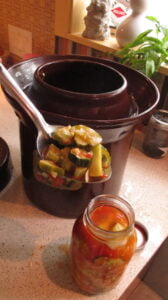
The fermenting frenzy continues. Last week, I was given a half a bushel of heirloom cucumbers, some with lovely ridged skins. I used them to make hot fermented pickles with my own fermented garlic chile paste and ginger. I call them Kim-Kosher pickles. Korean Kimchi is made according to a very sophisticated technique involving multiple brines and rice flour, Kosher pickles are often fermented in a brine with garlic. These are somewhere in between.
My efforts at creating a fermented pepper recipe for the Louisiana hot sauce are complete. Thanks to your comments I learned that it’s a lot easier to ferment whole red chiles cut into coarse chunks than to try to ferment a gloppy mash. After you ferment the chiles, you turn them into mash in a food processor. I also learned from Sandor Katz’s book, “The Art of Fermentation,” that its a great idea to ferment all the ingredients together, so I added garlic and onions to the red peppers.
The fermented red jalapeño, garlic and onion mash tastes so good, my wife and I are smearing it all over everything. I cut the mash 50-50 with Steen’s cane vinegar and put the mixture through a coarse sieve to remove the seeds and skin. The resulting pepper sauce is even better than previous batches.
The mash is incredibly versatile. Chris Shepherd at Underbelly showed me how to combine some of it with fish sauce, lime juice and sugar to make a very tasty nuoc cham. I also used the mash in the Kim-Kosher pickles and will soon use some to make the highly seasoned fermented cabbage Katz calls “kraut-chi.”

But all was not lost. My favorite pickled jalapeños are the crunchy little pods bottled by Trappey’s. On a visit to their Louisiana headquarters years ago, I discovered that the company ferments the peppers in giant concrete vats full of brine. So while my fermentation experiment was a failure, I am not all that sad about it. Yes, I was trying to make green Tabasco, not Trappey’s-style pickled jalapeños. But several bottles full of crunchy pickled jalapeños isn’t such a bad consolation prize.
To start your own fermented peppers, chop peppers, mix with two tablespoons salt per pound and mash them in a bowl. Then fill a fermenting crock or Mason jars with the mixture. If the peppers don’t make enough liquid to cover, add some water that has been boiled and cooled to remove chlorine. Keep the peppers under the liquid (cut a cabbage core disk to fit in the bottle if necessary) and allow to sit for several days in a loosely sealed jar.